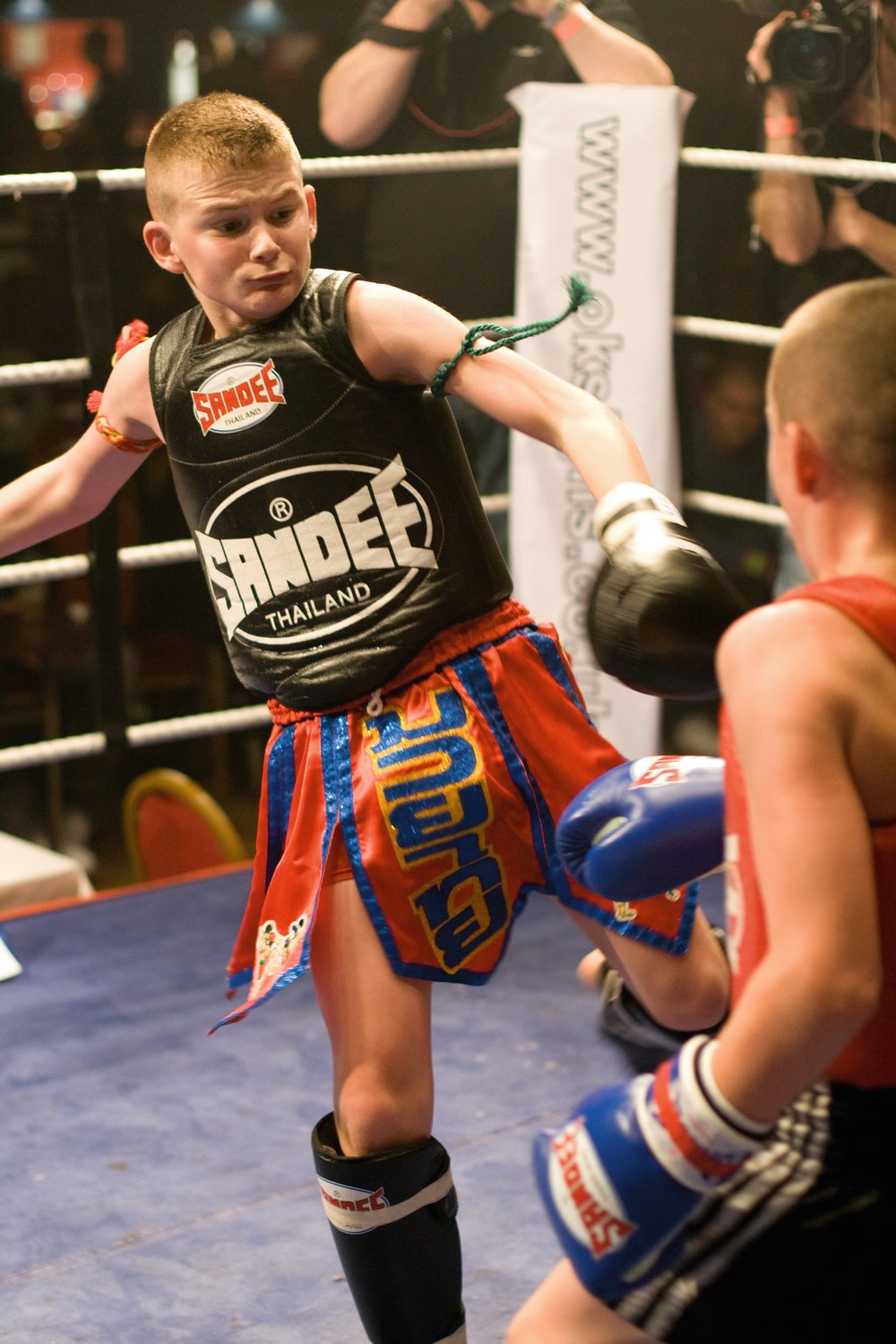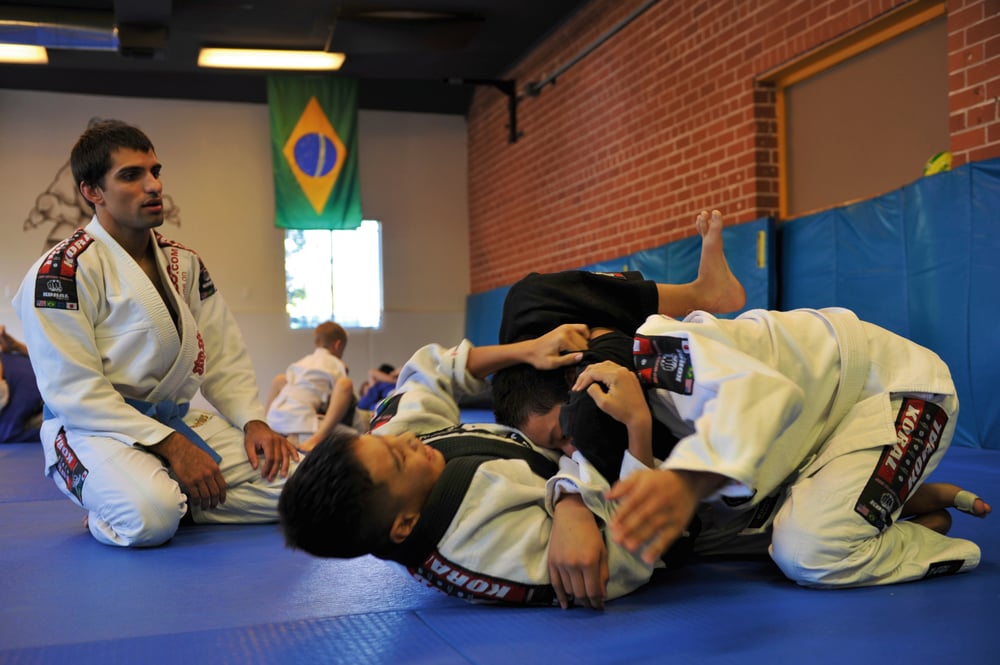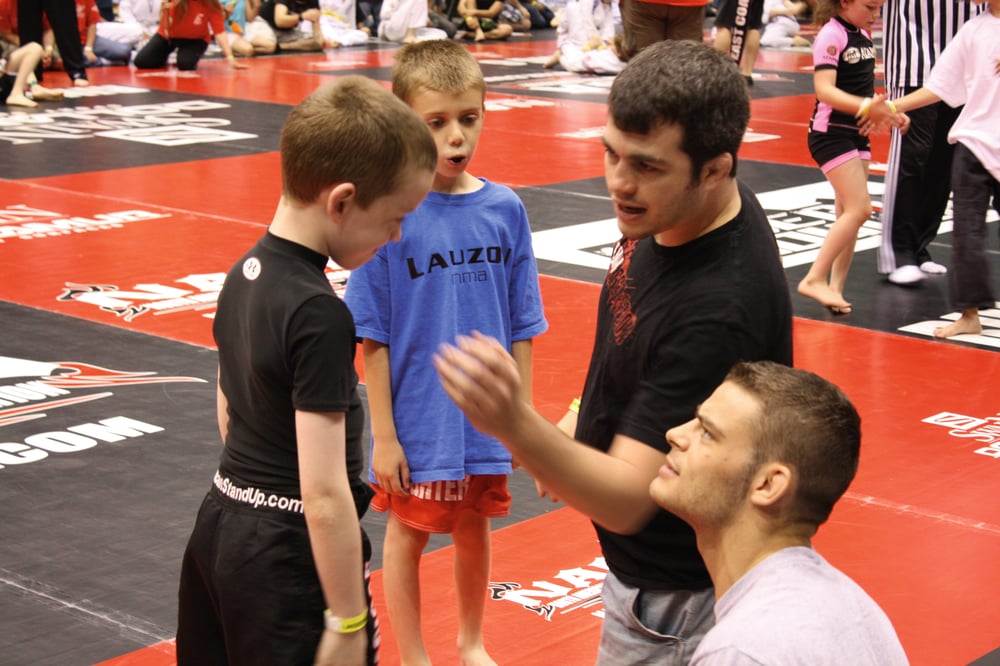
Issue 067
November 2010
Kids are training in MMA from infancy, and great things are predicted of them. FO meets the next generation – for once trash talk is not encouraged.
Carlos Ruffo Sr uses one word to describe the reaction of professional fighters to his three sons: “Amazement.” Training in the facets of MMA since 18 months old or younger, Carlos Jr (nine), Giovanni (eight) and Royce (four) are already being labeled ‘The Future of MMA.’ The boys split their time between Randy Couture’s and Wanderlei Silva’s gyms while in Las Vegas. In California they train at the Wild Card Gym belonging to boxing trainer Freddie Roach, and at the gym of Mark Munoz, UFC middleweight and training partner of Anderson Silva, Lyoto Machida and Jose Aldo. That’s when they’re not in school of course. The Ruffo boys hold demonstrations at martial arts exhibitions across America, have traveled to Abu Dhabi to conduct seminars at schools at the request of the royal family of Dubai and boast sponsorship from TapouT. People across the MMA world are already starting to postulate on what these three will be capable of when they’re 18 years old.
But Carlos Sr, who has a background in Thai boxing, says that he and his wife never intended to produce ‘The future of MMA’. “I worked during the day and my wife was working during the night, and we didn’t have that much time to spend with the kids. So, we’d put them in a class and go out there and do it together with them. I would go home and train with the kids and we would box and play – that’s the way we did it. We just spent quality time. Our major goal was just to get them socialized and somehow my sons took it to a different level.”
Randy Couture spotted the boys’ exceptional skills while they were hitting pads with their father at his famed Las Vegas gym, Xtreme Couture. The former UFC champion offered them sponsorship and word spread. Soon other fighters wanted to train with these wunderkinds. Today the boys learn Brazilian jiu-jitsu from Robert Drysdale, multiple-time grappling champion, train wrestling with Mark Munoz, California State wrestling hall of famer, and study Muay Thai from Master Quentin Chong, the retired and undefeated star of the ‘art of eight limbs’. The boys’ passion for fighting MMA comes from a simple source. “I love to compete,” states Carlos Jr, the eldest of all three brothers. “It doesn’t matter if I win or lose, I just want to be able do what I love for as long as I can.” Would he ever stop training? “No. I love it too much,” he confesses.
“Everybody always thinks, ‘Oh, the parents, they push the kids,’” says Carlos Sr. “But I think that’s the worst thing you can do. We try to take it away from the kids. If they don’t do their chores or their homework they’re not going to train. So as soon as they get home they’re busting their butts.” Carlos doesn’t let their education suffer and states that in school “they’re expected to be nerds.” He says: “They’re honor-roll kids at school. People there have no idea they do this – other than their Mohawks.” In fact, the family have their sights set on getting a top-notch education through college wrestling then going on to the Olympics. Carlos Jr and Giovanni are so enthusiastic they even already have colleges picked out: Iowa and Oklahoma respectively.

While the kids themselves are eager to get into the fight game, contrary to what many might expect, Carlos Sr wouldn’t like to see his sons become professional fighters. “I really want to see them go to the Olympics, do the wrestling, do something great, maybe open their own gyms and coach somebody.” If the boys, who actually join in on pro practices when they train, do choose to make the jump, Carlos says they’ll be well prepared. “We train everything separately, and then later in life, if that’s what they want to do, we have Randy [Couture] and some really good people that would put it all together for them.” The training experience described by Giovanni Ruffo (who lists Randy Couture as a favorite fighter alongside BJ Penn and his former Muay Thai coach at Xtreme Couture, Master Quentin Chong) gives a startling insight into the boys’ immense promise. “It makes me feel good. The more I train the faster and better I get, and the less I have to think about what move to use. My body knows what to do.”
While the Ruffo brothers are without doubt exceptional, the phenomenon of youngsters training in MMA from a young age is spreading. In fact, these prodigies are already starting to make their mark.
One such example is Rory MacDonald, UFC welterweight. Though he’s best known for his impressive near-upset over Carlos Condit at UFC 115 in June, Rory’s undefeated path to the UFC (filled with title belts and quick wins) started when the Canadian was only 14 years old. “My first class I did [in MMA], I walked away knowing that’s what I wanted to do,” reveals Rory. Just six months later he entered his first grappling tournament. Though he lost, it showed the eager British Columbia native what he needed to improve. “The next bunch of tournaments I came into I was very successful and then eventually I grew out of grappling tournaments and I turned to professional fighting.” For Rory it was a journey that began when he was a mere six years old watching early UFC events at home. Considering his age, were his parents ever worried about their son competing in a sport seen as very much a ‘man’s game’? “My mum was. She was a little bit scared. But now she’s the biggest supporter and loves it the most. My dad always thought it was really cool, that I fit it really well. My mum was concerned but she’s there every fight.”

Kids are now taking to the ring everywhere. From the AACC dojo in Tokyo, where young children relentlessly drill takedowns, to the high schools of Wisconsin, with students learning MMA as part of their school day, kids are being drawn to the fast-paced and colorful world of mixed martial arts. In Bridgewater, Massachusetts, at the gym of UFC lightweight Joe Lauzon, the interest in their children’s classes has risen over the past 12 months. Matt Perry and Greg Pomfred, who run the kids’ program, say that classes have gone from an attendance of five in 2009 to 12 this year, a remarkable increase for a town of just under 1,700 people. Greg states that some students have even turned down playing other extracurricular sports because it would interfere with their jiu-jitsu. Matt says that classes “focus more on grappling” with some pad work as well. “We also don’t put as much emphasis on submissions as we do with the adults.” However, Greg and Matt are still aiming to improve their students’ competitive skills. “While we may go over a combination or go over submissions for instruction,” describes Greg, “the kids drill takedowns and takedown defense every class.” He explains that it’s both to equip the kids with the tools for positional dominance and to help them when they take to the mat competitively. Joe Lauzon, who was once a teenager learning MMA, says that classes also provide benefits outside of the skills taught. “I think training kids in MMA teaches them balance, coordination and how to use their body. A lot of kids are awkward at first because they are never challenged in these areas and MMA fills that need.”
But while even die-hard fans of the sport accept there are risks involved in MMA, that same trepidation has to be amplified when the involvement of children is considered. As is to be expected, there are medical concerns. The danger of blows to the head is more severe for kids as their bones, muscles and brain tissue have not yet reached maturity – thus heightening the risk of concussion. Furthermore, the threat of submission holds is more severe for children. While an adult body can withstand a certain amount of pressure to a joint, a child’s cannot. Aside from the face-value disadvantages of injury, if damage, such as a break, were to occur to a child’s joint not fully transitioned from cartilage to bone, growth plates (responsible for longitudinal development of bones) could be affected.
Trainers such as Greg Pomfred at Lauzon MMA are very keen to ensure their students avoid engaging in the elements of the sport that could cause serious damage. “I don’t let the kids spar striking with each other,” clarifies Greg. “Usually they’ll hold pads for each other or I’ll hold pads for them. I’ll let them grapple, but I like to keep an eye on them – especially when they’re going for submissions.” Joe Lauzon explains he’s happy for children to grapple as either party can stop at any time but explains he doesn’t agree with them physically striking each other. “I don’t like the idea of kids getting hit in the head and sparring, until they’re older. As adults your head is a lot harder and you’re making the decision of when to quit. I think some kids feel pressured by parents and would take unnecessary abuse if they were doing striking.”
The emotional impact of MMA on a young child also has to be considered. Most children simply don’t have the ability to cope with a loss psychologically. While this might not affect those who only train, some compete in grappling tournaments or similar events. Losing a match at a small jiu-jitsu competition could have a disproportionately detrimental effect on a child’s confidence. They may, accurately or not, feel immense undue pressure to win, either from themselves or parents. But for Carlos Ruffo Sr and his boys it’s not an issue. “Losing’s not a hard thing,” says Carlos as he reveals a light-hearted approach to competition that he’s fostered from the off. “A lot of parents, you’ll go to wrestling tournaments or jiu-jitsu tournaments and it’s like the end of the world when their kids lose. It’s funny to us because I’m looking at the parents like, ‘You got to be kidding me. That kid’s only nine years old, he has a whole life ahead of him and you’re worried about this? In a few years this won’t mean anything.’” Carlos’ perspective is a refreshing one and it should be more commonplace. “We have no pressure like that,” he says. “If that’s the worst thing that’s going to happen, that we lose this tournament, we’re having a good day,” divulges Carlos. Besides, children’s competition in other mainstream sports is fully acceptable and presumably kids would have the same reaction to a loss there as they would in a combat competition. While these emotional hurdles are never desirable, MMA shouldn’t be singled out as being the sole dispenser.
There is always a risk of kids imitating any sport in uncontrolled circumstances and MMA is no different. Unfortunately YouTube is littered with videos of school kids scrapping while utilizing Octagon-proven techniques. Nothing is certain to prevent children from copying what they see on television. But when children take MMA classes one of the first things they’re taught is that those techniques are not to be used outside of the ring. Rory MacDonald received that direction from his trainer Dave Lea from the off: “He taught me what martial arts are really about: respect, honor and truth.” Similarly, Carlos Ruffo Sr has taught his boys never to take their training into school with them. “I always tell my kids, ‘The kid that says nothing is always the most dangerous one. The one that stands back, that’s the one you want to be.’”
So, what of the future? With children training in MMA exclusively, and from a young age, what kind of fighters are we going to see enter the Octagon in ten years? Carlos Ruffo Sr predicts abilities from his sons that are “beyond” what is currently the norm. “With my kids, everything’s going to be instinct for them. Some guys in MMA have never boxed before, by that time my sons would have had a hundred boxing fights and be at a pro level for boxing. We have Freddie Roach, who trains Manny Pacquiao and everybody else, so their footwork and their movement are going to be insane. We train with Anderson Silva and Rafael Cordeiro [famous Chute Boxe trainer] so their Muay Thai’s going to be solid. We’re going to be college wrestling and for our jiu-jitsu we’ve got Robert Drysdale, Abu Dhabi champion, so I’m pretty sure we’ll be ready there too.” Greg Pomfred agrees that lifelong mixed martial artists will “put people like St Pierre to shame” but warns that expecting any child to remain dedicated and interested in a sport through adolescence is quite a demand. “But those rare cases of kids who stay with it into adulthood,” offers Greg, “will do to Fedor what he did to Mark Coleman.”
With these upgraded fighters will we see an upgraded sport? What’ll happen when the competitors have become supermen of the full MMA discipline? “I think more fights will be decided in the scramble,” suggests Joe Lauzon. “When we talk about guys ‘getting caught’ it will be in those intermediate stages between stand-up and ground.” That raises an interesting point. One of MMA’s biggest selling points is the decisive knockouts and submissions so scarce in other combat sports. That often happens when a strike-heavy fighter manages to keep a grapple-strong warrior on the feet and vice versa. With these well-rounded athletes balanced in all areas, able to land a right cross with as much ease as locking down a kneebar, will these battles be going to the judges more often? We can’t be certain, but Rory MacDonald doesn’t think it will be the case. “In our sport, we’ve got little gloves on and athletes are explosive,” determines Rory. “It’s just the sport. I don’t think the knockout ratio or the decision ratio is going to increase.” MacDonald explains that in years to come he expects to watch a more fast-paced fight style where fighters effortlessly glide between jiu-jitsu and stand-up prowess. Matt Perry, from Lauzon MMA, suggests: “There is definitely a new breed of fighter being built by this generation… We’ve got guys dominating the takedowns or dominating the striking because they had so much more exposure to these things in their past art or sport. I’m not saying that we are going to see the end of styles as a result of full-on MMA training from the start, but we are going to see the blurring of stylistic barriers.”
It’s immensely exciting to think about the skill children training in MMA today might possess in years to come, and how it might affect the sport. Not only will it change the game in the cage but it could also improve the social acceptance of MMA – these children are the decision-makers of tomorrow after all. For Carlos Ruffo Sr it’s all about letting his children be who they want to be. It just so happens that for his kids, they want to eat, sleep and drink MMA. “My kids are very competitive and when they go home, a lot of kids play cops and robbers or they play PlayStation, my kids have wrestling mats in their room and all I hear is them wrestling and drilling. I tell them they can stop training and they’re like, ‘Dad, we’re not training. I’m playing Randy Couture and he’s playing Robert Drysdale or Wanderlei Silva.’ That’s the way they play, they fight UFC fights. In reality when you watch them play they’re actually training.” The real benefits of training MMA are gained by the children themselves, from gaining confidence and getting healthy, to potentially providing these kids with an education by wrestling in college, having a career as a coach or, if they choose, a fighter. Whatever becomes of all these little Octagon prodigies the future of MMA looks extremely exciting.
Brave new world: MMA's teenage prodigies
Drake ‘Ultimo’ Dudley
Drake Dudley is a 16-year-old fight phenom who has studied combat sports since he was five. With the guiding hand of his father Kirk from seven years old Texas-based Drake has taken part in over 500 matches across Brazilian jiu-jitsu, boxing, wrestling, judo and children’s pankration. Between all of these disciplines he holds wins in roughly 86% of his bouts. Whether Drake, who gained his nickname from a coach on a training trip to Brazil, will definitely take his fight-proven skills pro is unknown.
Alexi Argyriou
A fight protégé from the same camp as Strikeforce women’s bantamweight champion Sarah Kaufman, Alexi Argyriou has already been signed by Canadian promotion MFC despite only being 16 years old. Described as “the future” by promotion owner Mark Pavelich, and as having “special qualities that make him different” by his trainer, the future may be very bright for Argyriou. The MMA world will be watching intently when he makes his professional MMA debut at 18.













